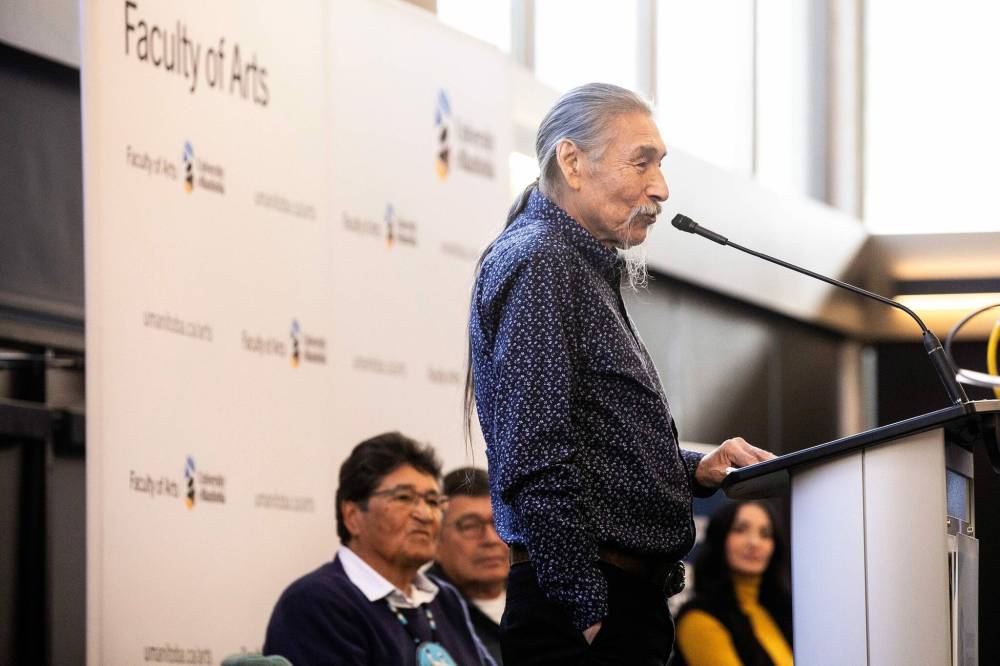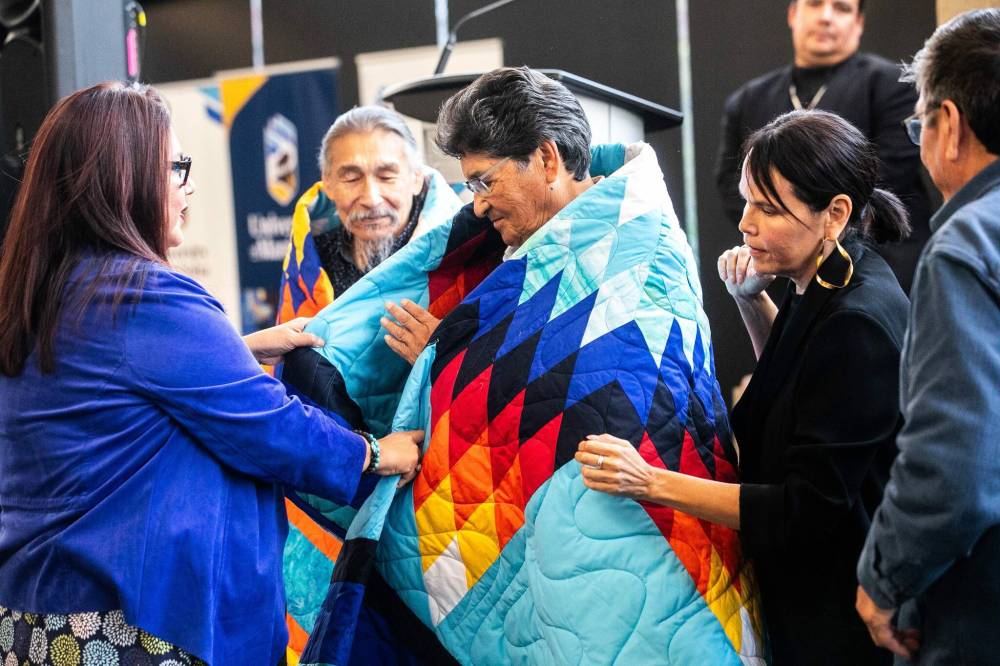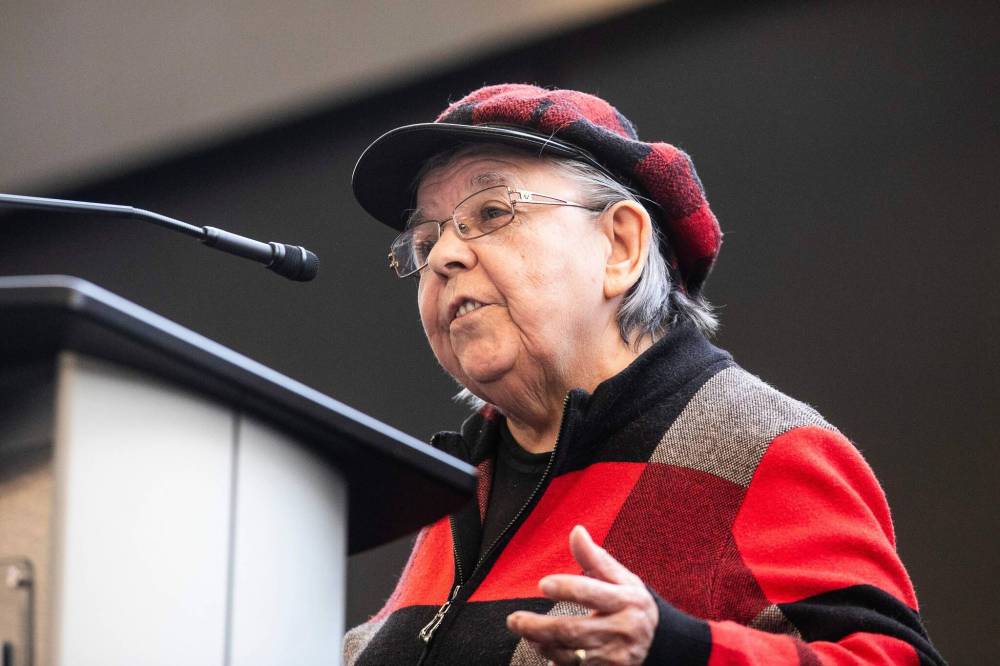U of M Indigenous studies department reaches milestone
Advertisement
Read this article for free:
or
Already have an account? Log in here »
To continue reading, please subscribe:
Monthly Digital Subscription
$0 for the first 4 weeks*
- Enjoy unlimited reading on winnipegfreepress.com
- Read the E-Edition, our digital replica newspaper
- Access News Break, our award-winning app
- Play interactive puzzles
*No charge for 4 weeks then price increases to the regular rate of $19.00 plus GST every four weeks. Offer available to new and qualified returning subscribers only. Cancel any time.
Monthly Digital Subscription
$4.75/week*
- Enjoy unlimited reading on winnipegfreepress.com
- Read the E-Edition, our digital replica newspaper
- Access News Break, our award-winning app
- Play interactive puzzles
*Billed as $19 plus GST every four weeks. Cancel any time.
To continue reading, please subscribe:
Add Free Press access to your Brandon Sun subscription for only an additional
$1 for the first 4 weeks*
*Your next subscription payment will increase by $1.00 and you will be charged $16.99 plus GST for four weeks. After four weeks, your payment will increase to $23.99 plus GST every four weeks.
Read unlimited articles for free today:
or
Already have an account? Log in here »
It was a day of celebration and of recognition Wednesday, as the University of Manitoba Indigenous studies department marked a half-century of scholarship, honouring decades of students and scholars in their pursuit of justice for Indigenous peoples.
It was also a day of deep emotion, as speakers grappled with the complicated history and legacy of education for Indigenous students in Canada – a history that has included residential schools, broken treaty promises, and university spaces that made Indigenous students feel alone and alienated.
In 1970, for instance, of the more than 13,000 students enrolled at the University of Manitoba, only about 50 were Indigenous.

MIKAELA MACKENZIE / FREE PRESS
Moses Okimaw, one of the early members of the University of Manitoba's Indigenous students association, speaks at an event celebrating 50 years of Indigenous studies at the University, Wednesday.
It was in the early 1970s that the newly formed Indian, Métis and Eskimo Student Association (IMESA) began fighting for the creation of a Native studies department on campus, which they achieved in 1975. The goal was to create a place for Indigenous students to belong – and to learn about themselves.
It would become the second Indigenous studies department in Canada.
“I haven’t thought of ever leaving behind a legacy at this university. I never thought of that, that what we did benefited other students. It never entered my mind,” said Moses Okimaw, one of the early members of the Indigenous students association, who spoke at Wednesday’s event alongside Edwin Jebb and Ovide Mercredi, two other early association leaders, who are each in their 70s.
“I hope that students continue to benefit from what we did here,” Okimaw added.
The first Indigenous studies program in Canada was launched in 1969 at Trent University in Peterborough, Ont., led by the longtime Anishinaabe educator Waubageshig (Harvey McCue). It was a time of political reckoning for Indigenous people in Canada. That same year, the government of Pierre Trudeau released a policy document, known as the White Paper, that advocated for the dissolution of Indian status and the Indian Act.
Under great pushback from Indigenous leaders, the policy was tossed, but not before it ignited growing dialogue about Indigenous education. For instance, in 1972, with the National Indian Brotherhood’s “Indian Control of Indian Education,” which argued for Indigenous control over Indigenous education. “(Indigenous post-secondary students) would be further encouraged if the Indian language is recognized for the second language requirement and a native studies program has a respected place in the curriculum,” the document argued.
Since the 1970s, Indigenous studies departments have found a place at many, if not most, Canadian universities, and this year, the University of Manitoba marked the highest enrolment of Indigenous students in its history — more than 3,200 — with 231 students enrolled in either a major or a minor in Indigenous studies.
Yet the path for these departments has not always been easy: facing cuts, funding scarcity and threats of dissolution, as was nearly the case at York University in Toronto earlier this year, and as briefly took place at the University of Manitoba in 1982, though the suspension was reversed after significant uproar, led by the department’s own scholar, Emma LaRocque.

MIKAELA MACKENZIE / FREE PRESS
Carla Loewen, University of Manitoba Indigenous Student Centre director (left), and Lorena Fontaine, department head (right), present Ovide Mercredi with a star blanket at the event, Wednesday.
In her opening remarks, Lorena Fontaine, the current head of the department, told those gathered for the 50-year celebration how calls for the department had come out of a moment of hurt. In 1971, a racist article, full of demeaning stereotypes, had been published in a school newspaper by several engineering students. In response, the Indian, Métis and Eskimo Student Association, which had been founded that same year, mounted a public campaign.
“IMESA responded with determination. They demanded accountability, educated the campus, and turned the moment of harm into a call for change,” Fontaine said.
Ovide Mercredi, who was, in 1971, the president of the student association, and would later became the national chief of the Assembly of First Nations, told the crowd about their response to the article: they hired a lawyer and recruited allies; met with the university’s president and board of governors; and educated the dean of engineering, as well as the students who had written the piece. In the midst of this, they began calling for the creation of an Indigenous studies department.
In a 1972 proposal published in the Manitoban, the student association wrote that Indigenous students were limited to studying the heritage of their “conquerors,” and while some university courses acknowledged Indigenous people, “our people and our heritage are studied in most faculties as quaint curiosities of a by-gone days.”
“What we realized, as we were going to school, is where are we going to learn about ourselves from this institution? Who’s going to teach us anything about our history, about our politics, about our nationhood, about our sovereignty?” Mercredi told the crowd. “There was no place to go.”
“One of the objectives, I think, of native studies is about doing justice — not just about, ‘here’s a book, go and read it,’ or, ‘here’s knowledge, understand it.’ It’s about advocacy for justice,” Mercredi added.
Wednesday’s event also recognized LaRocque, who, in 1975, published Defeathering the Indian, a seminal book that tackled stereotypes about Indigenous people, as well as Niigaan Sinclair, a professor and former department head of the Indigenous studies program (as well as a columnist at the Free Press), for his recent book, Wînipêk.
LaRocque, reflecting on her nearly five decades of teaching at the university, referred to it as the honour of her life, saying that with the very first classes she taught, “I knew I had found my vocation.”

MIKAELA MACKENZIE / FREE PRESS
Emma LaRocque speaks at the event celebrating 50 years of Indigenous Studies at the University of Manitoba.
Carl Stone, an elder-in-residence at the university, closed the event with an honour song for Jebb, Mercredi and Okimaw.
Before he drummed, though, Stone reflected on his own educational journey at the university, including hearing LaRocque speak in the late 1970s.
“Everything that I know about me, and the love I have for myself, the knowledge I have about my people, and the love that I have for my people, came from my own people,” Stone said, choking up.
marsha.mcleod@freepress.mb.ca

Marsha McLeod
Investigative reporter
Signal
Marsha is an investigative reporter. She joined the Free Press in 2023.
Our newsroom depends on a growing audience of readers to power our journalism. If you are not a paid reader, please consider becoming a subscriber.
Our newsroom depends on its audience of readers to power our journalism. Thank you for your support.

